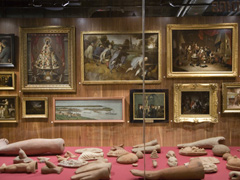


The Wellcome Collection may well be London’s best museum. Its contents are nothing short of thrilling, in equal measures educational and bizarre - how can one not get excited by a shrunken head with a full head of hair?
The centre’s exhibitions change frequently, and while they usually deal with subject matter related to the medical world, they are of a questioning nature, tackling complex themes that can hit a raw nerve; take for instance Bobby Baker’s Diary Drawings, in which the performance artist detailed her descent into mental illness and recovery in various clinics and psychiatric wards via a series of simple yet heart-wrenching drawings. Sleeping & Dreaming concluded that little is known about what happens when we shut our eyes, and featured a spectacular painting by Goya. A more recent exhibit delved into the murky world of dirt, which explored society’s attitudes to muck throughout the centuries with depictions of filthy scenes and the creepy crawlies that inhabit them.
Then there are the curious special events. The Handlebar Moustache Club have congregated here, to compare the anatomical position of their hirsuteness and dole out styling tips. The educational talks can be serious or light-hearted, some of which have even included dinner and wine. What could be better than to have your mind stimulated by the UK’s premier mathematician and stand-up comedian over a two-course meal?
But the most captivating part of the museum lies in its permanent collection, Medicine Man, so extensive it can only have been the work of an obsessive collector. There is no doubt that the man responsible for all this led a most fascinating life. Sir Henry Wellcome, born in 1853 in Wisconsin, was a pharmacist, inventor and entrepreneur. It was he who first invented the word “tabloid”, by joining together “tablet” and “alkaloid”, to describe his newly compressed pill, which for the first time made it possible to take accurate doses of medicine (a mortar and pestle was the most usual method up until that point). And \n\nWellcome was precocious and hard-working, training as an apothecary whilst studying, and he found work within a pharmaceutical firm very soon after graduating. His main interest lay in the production of new drugs, and one of his first projects involved finding new sources of Cinchona bark in the South American rainforests to make quinine, important in the treatment of malaria. At the age of 27 he moved to London to set up a business alongside Silas Burroughs. The two were talented salesmen, securing “celebrity” endorsements for their products at a time when such things were unheard of. Scott of the Antarctic, Edward VII and various Prime Ministers were customers.
In 1894 Wellcome set up a research lab – unheard of for a private company at the time – and made important inroads in finding a cure for diphtheria, then a major killer. He was also a great philanthropist, promoting the cause of Native Americans (even if his methods were questionable, as he followed the general consensus at the time that they should be converted to Christianity), funding archaeological excavations in Sudan and providing employment to the locals, and finally establishing the Wellcome Trust. The charity is the second biggest medical charity in the world, and spends around £500 million on research each year.
\n\nThroughout his career he was an avid collector. In fact so great was his fascination with collecting that he employed staff around the world to collate objects on his behalf. Wellcome himself used pseudonyms so that dealers were unaware of his identity and didn’t increase their prices for his benefit. The fruits of these endeavours are what make the Wellcome Collection a truly amazing museum. While a large portion of the artefacts on display are related to medicine, others are purely historical or artistic, such as the Islamic horoscopes, Sanskrit manuscripts and ancient Chinese paintings. But the main attraction has to be the more subversive elements in Medicine Man; the human remains, the shrunken heads, the Chinese torture chairs covered in spikes, and the headpiece made out of a real skull, decorated with semi-precious stones (the youngest members of the family might find these a little disturbing). Then there are the Japanese dildos and the heavy iron chastity belt which looks more than a little painful to wear, until you learn it is lined with velvet. Other curiosities Wellcome amalgamated in this lifetime include Napoleon’s toothbrush and of course, dozens of surgical instruments from yesteryear.
Finally, the last reason to persuade visitors to venture to the Wellcome Collection has to be the fact that admission to the permanent galleries and exhibitions is always free, making them accessible to all.
Wellcome died in 1936, having attained a knighthood, acquisitions to rival those of the British Museum, and a large personal fortune which has since been ploughed into projects like the first anti-leukaemia drug, developed at the Burroughs Wellcome Research Laboratories in New York. And naturally, he also left behind London’s greatest museum.


